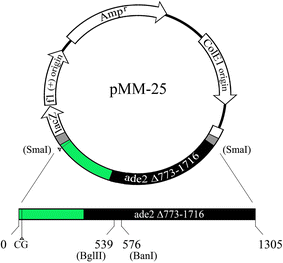Saccharomyces cerevisiae-based system for studying clustered DNA damages
- PMID: 20552213
- PMCID: PMC2906745
- DOI: 10.1007/s00411-010-0303-3
Saccharomyces cerevisiae-based system for studying clustered DNA damages
Abstract
DNA-damaging agents can induce clustered lesions or multiply damaged sites (MDSs) on the same or opposing DNA strands. In the latter, attempts to repair MDS can generate closely opposed single-strand break intermediates that may convert non-lethal or mutagenic base damage into double-strand breaks (DSBs). We constructed a diploid S. cerevisiae yeast strain with a chromosomal context targeted by integrative DNA fragments carrying different damages to determine whether closely opposed base damages are converted to DSBs following the outcomes of the homologous recombination repair pathway. As a model of MDS, we studied clustered uracil DNA damages with a known location and a defined distance separating the lesions. The system we describe might well be extended to assessing the repair of MDSs with different compositions, and to most of the complex DNA lesions induced by physical and chemical agents.
Figures



Similar articles
-
Clustered DNA lesion repair in eukaryotes: relevance to mutagenesis and cell survival.Mutat Res. 2011 Jun 3;711(1-2):123-33. doi: 10.1016/j.mrfmmm.2010.12.010. Epub 2010 Dec 24. Mutat Res. 2011. PMID: 21185841 Free PMC article. Review.
-
DNA repair of clustered uracils in HeLa cells.J Mol Biol. 2005 Jan 28;345(4):731-43. doi: 10.1016/j.jmb.2004.10.079. J Mol Biol. 2005. PMID: 15588822
-
Effects of DNA double-strand and single-strand breaks on intrachromosomal recombination events in cell-cycle-arrested yeast cells.Genetics. 1998 Jul;149(3):1235-50. doi: 10.1093/genetics/149.3.1235. Genetics. 1998. PMID: 9649517 Free PMC article.
-
Conservative repair of a chromosomal double-strand break by single-strand DNA through two steps of annealing.Mol Cell Biol. 2006 Oct;26(20):7645-57. doi: 10.1128/MCB.00672-06. Epub 2006 Aug 14. Mol Cell Biol. 2006. PMID: 16908537 Free PMC article.
-
Sex and the single (double-strand) break.Mol Cell. 2002 Apr;9(4):700-2. doi: 10.1016/s1097-2765(02)00512-9. Mol Cell. 2002. PMID: 11983162 Review.
Cited by
-
Determining survival fractions of Saccharomyces cerevisiae in response to ionizing radiation in liquid culture.J Radiat Res. 2018 Nov 1;59(6):760-764. doi: 10.1093/jrr/rry070. J Radiat Res. 2018. PMID: 30165406 Free PMC article.
-
Dissecting Highly Mutagenic Processing of Complex Clustered DNA Damage in Yeast Saccharomyces cerevisiae.Cells. 2021 Sep 3;10(9):2309. doi: 10.3390/cells10092309. Cells. 2021. PMID: 34571958 Free PMC article.
-
Clustered DNA lesion repair in eukaryotes: relevance to mutagenesis and cell survival.Mutat Res. 2011 Jun 3;711(1-2):123-33. doi: 10.1016/j.mrfmmm.2010.12.010. Epub 2010 Dec 24. Mutat Res. 2011. PMID: 21185841 Free PMC article. Review.
References
-
- Burke DT, Dawson D, Searns T (2000) Laboratory course manual for methods in yeast genetics. Cold Spring Harbour Laboratory Press, Cold Spring Harbour
Publication types
MeSH terms
Substances
LinkOut - more resources
Full Text Sources
Molecular Biology Databases
Research Materials
Miscellaneous

